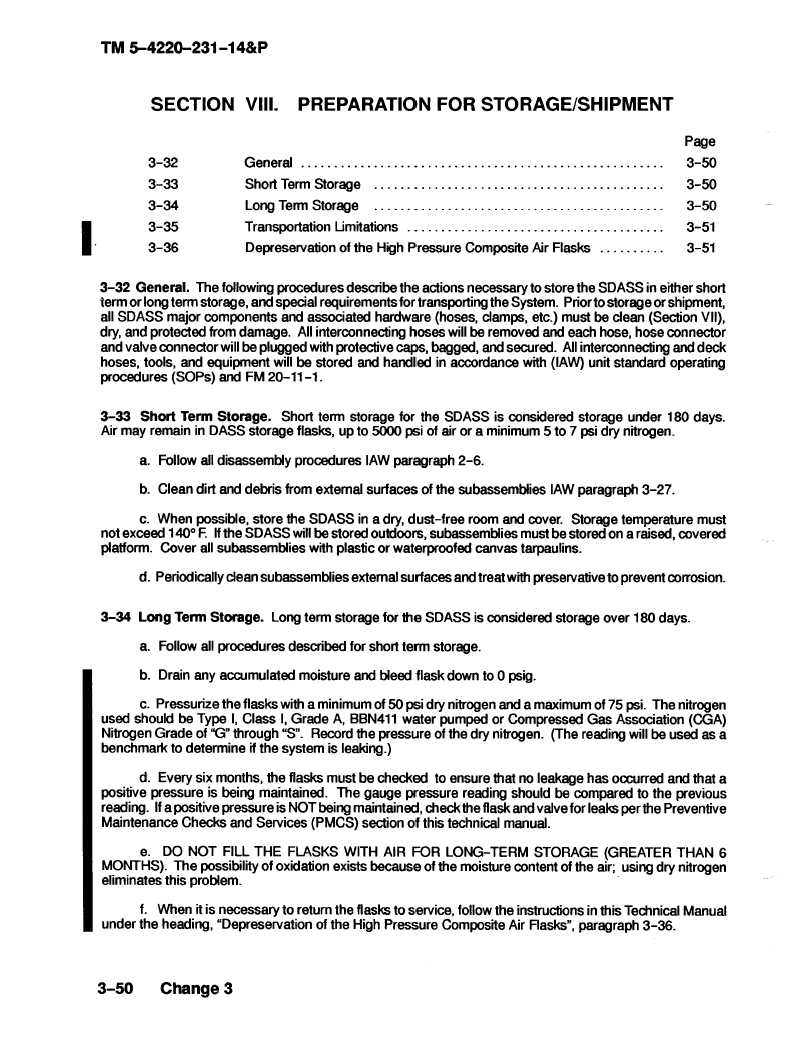TM 5-4220-231-14&P
SECTION
VIll.
PREPARATION
FOR STORAGE/SHIPMENT
Page
3-32
General
.......................................................
3-50
3-33
Short Term Storage
............................................
3-50
3-34
Long Term Storage
............................................
3-50
3-35
Transportation
Limitations
.......................................
3-51
3-36
Depreservation
of the High Pressure Composite
Air Flasks
..........
3-51
3-32 General.
The following procedures
describe
the actions necessary
to store the SDASS in either short
term or longterm
storage,
and special requirements
for transporting
the System.
Prior to storage or shipment,
all SDASS major components
and associated
hardware
(hoses, clamps, etc.) must be clean (Section VII),
dry, and protected
from damage.
All interconnecting
hoses will be removed and each hose, hose connector
and valve connector
will be plugged with protective caps, bagged,
and secured.
All interconnecting
and deck
hoses,
tools, and equipment
will be stored and handled in accordance
with (IAW) unit standard
operating
procedures
(SOPs) and FM 20-11 -1.
3-33
Short Term Storage.
Short term storage
for the SDASS is considered
storage
under 180 days.
Air may remain in DASS storage
flasks, up to 5000 psi of air or a minimum 5 to 7 psi dry nitrogen.
a. Follow all disassembly
procedures
IAW paragraph
2-6.
b. Clean dirt and debris from external surfaces
of the subassemblies
IAW paragraph
3-27.
c. When possible,
store the SDASS in a dry, dust-free
room and cover.
Storage temperature
must
not exceed 1400 F Ifthe SDASS will be stored outdoors,
subassemblies
must be stored on a raised, covered
platform.
Cover all subassemblies
with plastic or waterproofed
canvas
tarpaulins.
d. Periodically
clean subassemblies
external surfaces
and treat with preservative
to prevent corrosion.
3-34
Long Term Storage.
Longterm
storage
for the SDASS is considered
storage
over 180 days.
a. Follow all procedures
described
for short term storage.
b. Drain any accumulated
moisture
and bleed flask down to 0 psig.
c. Pressurize
the flasks with a minimum of 50 psi dry nitrogen and a maximum of 75 psi. The nitrogen
used should
be Type 1,Class 1,Grade A, BBN411 water pumped
or Compressed
Gas Association
(CGA)
Nitrogen Grade of "G" through "S". Record the pressure
of the dry nitrogen.
(The reading will be used as a
benchmark
to determine
if the system
is leaking.)
d. Every six months, the flasks must be checked
to ensure that no leakage has occurred
and that a
positive pressure
is being maintained.
The gauge pressure
reading should be compared
to the previous
reading.
Ifa positive pressure
is NOT being maintained,
check the flask and valve for leaks per the Preventive
Maintenance
Checks and Services
(PMCS) section of this technical manual.
e.
DO NOT FILL THE FLASKS WITH AIR FOR LONG-TERM
STORAGE (GREATER THAN 6
MONTHS).
The possibility of oxidation exists because
of the moisture content of the air; using dry nitrogen
eliminates
this problem.
f. When it is necessary
to return the flasks to service, follow the instructions
in this Technical Manual
under the heading,
"Depreservation
of the High Pressure
Composite
Air Flasks", paragraph
3-36.
3-50
Change
3


